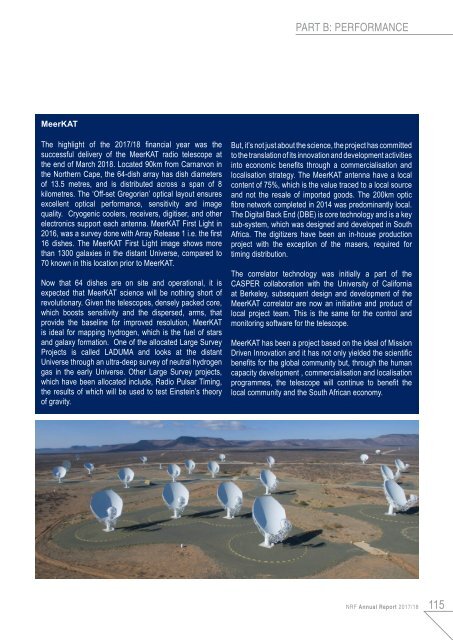NRF Annual Report 2018
Create successful ePaper yourself
Turn your PDF publications into a flip-book with our unique Google optimized e-Paper software.
PART B: PERFORMANCE<br />
MeerKAT<br />
The highlight of the 2017/18 financial year was the<br />
successful delivery of the MeerKAT radio telescope at<br />
the end of March <strong>2018</strong>. Located 90km from Carnarvon in<br />
the Northern Cape, the 64-dish array has dish diameters<br />
of 13.5 metres, and is distributed across a span of 8<br />
kilometres. The ‘Off-set Gregorian’ optical layout ensures<br />
excellent optical performance, sensitivity and image<br />
quality. Cryogenic coolers, receivers, digitiser, and other<br />
electronics support each antenna. MeerKAT First Light in<br />
2016, was a survey done with Array Release 1 i.e. the first<br />
16 dishes. The MeerKAT First Light image shows more<br />
than 1300 galaxies in the distant Universe, compared to<br />
70 known in this location prior to MeerKAT.<br />
Now that 64 dishes are on site and operational, it is<br />
expected that MeerKAT science will be nothing short of<br />
revolutionary. Given the telescopes, densely packed core,<br />
which boosts sensitivity and the dispersed, arms, that<br />
provide the baseline for improved resolution, MeerKAT<br />
is ideal for mapping hydrogen, which is the fuel of stars<br />
and galaxy formation. One of the allocated Large Survey<br />
Projects is called LADUMA and looks at the distant<br />
Universe through an ultra-deep survey of neutral hydrogen<br />
gas in the early Universe. Other Large Survey projects,<br />
which have been allocated include, Radio Pulsar Timing,<br />
the results of which will be used to test Einstein’s theory<br />
of gravity.<br />
But, it’s not just about the science, the project has committed<br />
to the translation of its innovation and development activities<br />
into economic benefits through a commercialisation and<br />
localisation strategy. The MeerKAT antenna have a local<br />
content of 75%, which is the value traced to a local source<br />
and not the resale of imported goods. The 200km optic<br />
fibre network completed in 2014 was predominantly local.<br />
The Digital Back End (DBE) is core technology and is a key<br />
sub-system, which was designed and developed in South<br />
Africa. The digitizers have been an in-house production<br />
project with the exception of the masers, required for<br />
timing distribution.<br />
The correlator technology was initially a part of the<br />
CASPER collaboration with the University of California<br />
at Berkeley, subsequent design and development of the<br />
MeerKAT correlator are now an initiative and product of<br />
local project team. This is the same for the control and<br />
monitoring software for the telescope.<br />
MeerKAT has been a project based on the ideal of Mission<br />
Driven Innovation and it has not only yielded the scientific<br />
benefits for the global community but, through the human<br />
capacity development , commercialisation and localisation<br />
programmes, the telescope will continue to benefit the<br />
local community and the South African economy.<br />
<strong>NRF</strong> <strong>Annual</strong> <strong>Report</strong> 2017/18 115


